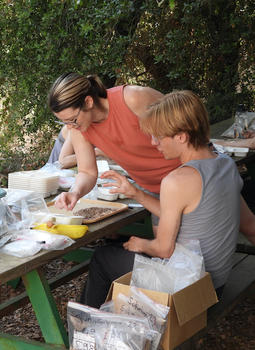George Mason University anthropologist Jamie Clark and two undergraduate students spent part of the summer on an archaeological expedition in Sefunim Cave, Israel.
Clark, an associate professor in the Department of Sociology and Anthropology, received a grant of $44,745 from the National Science Foundation (NSF) to conduct research at the site. The grant goes through early 2025.
“Getting this grant to focus on the analysis was important, and it's so exciting to have three years of funding,” said Clark. “We've had several excavation seasons since 2013, and with archeology you oftentimes spend more time doing analysis in the lab than you do in the field."
The research for this expedition focuses on the transition from the Neanderthals, which is associated with the Middle Paleolithic period, to modern humans, which is associated with the Upper Paleolithic, and the role of climate change throughout, she said.
Clark's NSF funded research is in collaboration with Gideon Hartman at the University of Connecticut. The excavations were led by Andrew Kandel of the Heidelberg Academy of Sciences and Humanities, University of Tübingen and Ron Shimelmitz of the Zinman Institute of Archaeology, University of Haifa.
The site they are excavating has deposits going back about 70,000-21,000 years ago, essentially the height of the very last ice age when glaciers were at their greatest extent, Clark said.
“During the last glacial maximum, there's also extreme variability in climate, which is something else we're seeing today with climate change,” said Clark.
Two undergraduate anthropology students who work alongside Clark in the zoo archeology lab in David King Hall were also able to work on the dig.

“One of the things that is most important to me is giving undergraduates paid research opportunities, so the grant also pays for the work that I'm having students do,” said Clark.
She said there is a potential barrier to entering the archaeology field for students of limited means. The jobs on digs are often volunteer or unpaid, which isn’t possible for many students.
“It's very hands-on, which is especially cool if you're still an undergrad. Not a lot of students can say that they have that kind of experience,” said Kelly Wilkerson, a senior anthropology major and one of Clark’s lab assistants. “We would be up early to hike one or two kilometers to get to the site around 7 a.m. We dug through the sediment that we uncovered and carried it down [to the lab] at the end of the day.”
Jett Liska, another one of Clark’s lab assistants, received an Undergraduate Research Scholars program grant from Mason’s Office of Student Scholarship, Creative Activities, and Research (OSCAR) program, which helped him participate in the expedition.
“The best part to me was really taking pride in my work and realizing that I was knowledgeable enough about the site to help incredibly smart people,” Liska said.
“One of the things that is most important to me is giving undergraduates paid research opportunities, so the grant also pays for the work that I'm having students do.”
Related Stories
- March 30, 2023
- August 15, 2022
- July 1, 2021
- May 27, 2021
- May 11, 2021
